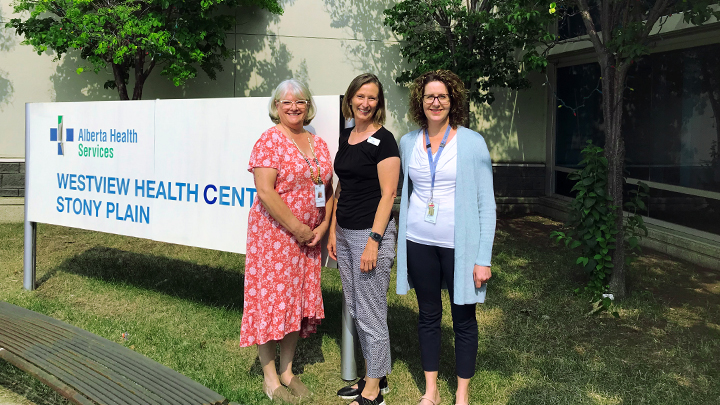
November 4, 2024

Administrative support Lavilla Cameron, site director Ellen Elliot, and clinical nurse educator Erin Dickner strike a happy pose outside of WestView Health Centre in Stony Plain, which has received glowing praise from Accreditation Canada’s auditors, identifying Communication Access here as an Area of Excellence. Supplied.
Story by Gregory Kennedy & Janine Poersch
STONY PLAIN — Clear two-way communication is key for people with speech, language and hearing difficulties who often need accommodations to be fully involved in their care and medical decisions.
WestView Health Centre quickly embraced this challenge — and has already won glowing praise from Accreditation Canada auditors — who have identified Communication Access as an Area of Excellence in the site’s communications-friendly environment.
This national kudos reflects years of dedication by the WestView team to be among the first to participate in an emerging program, Communication Access designation, to grow their capacity with education, resources and strategies to ensure patients and family members with communication needs are heard and supported to participate in their healthcare.
“The provincial Allied Health team reached out to me to ask if I would be interested in representing WestView on a committee regarding Communication Access. I admit I wasn't really sure what they meant at the time,” says site director Ellen Elliott. “But once I got involved, I rapidly and immediately felt compelled to be a part of that work. It’s really about people's right to be involved in their healthcare.
“We believe in their rights to be actively engaged as partners in care. And so I felt we must make significant efforts to improve how we enable people to participate — and the Communication Access initiative does just that. I was also impressed by the leadership of Julie Evans and the Allied Health team in developing this initiative and resources. I immediately I knew it would make things better for our patients, so we jumped on board.” Having these patients fully participate has also been shown to reduce preventable adverse events, improve health outcomes, and boost safety for all.
“It makes for safer healthcare when people can actively be heard and speak up,” adds Elliott. “It can reduce hospital re-admissions — and it really ensures that patients can understand their treatments, make decisions and provide feedback to their team.”
Research shows that at least one in six Albertans has a communication need or difficulty with understanding, hearing or putting thoughts into words. These numbers can be even higher for patients in care.
“When we rolled our initiatives out, staff were very receptive to the education and the toolkit packages that we distributed to them,” says Erin Dickner, a clinical nurse educator with WestView’s Family Medicine & Ambulatory Clinics who’s been leading the charge.
“I found it very reassuring that they wanted to be a part of this — and that they wanted to improve the patient experience as well.”
Tools already distributed among WestView staff include items such as pointing boards (with words on them), pictures and dry-erase boards for drawing and writing. Other strategies can include sign language interpreters, gestures and body language, or using the patients’ hearing or speech-generating devices.
“I think what’s been the most beneficial is having the signage available so that everyone is aware that their patient has a need,” says Dickner, “so they can communicate better with them.”
“Thank goodness,” adds Lavilla Cameron, who works in administrative support and occasionally the registration desk. “I just feel like this has given everyone in the hospital the tools we need. So instead of stumbling over words, we have our tools. It’s helped staff a lot.
“I now keep writing materials handy. I can say: ‘Would you like paper and pen?’ If they say ‘yes’, I hand it to them. Instead of making them read my lips through plexiglass, we can write back and forth to each other. Now we’ve got great communication — and neither I nor our patient have to stumble or worry.”
Respect for the patient also lies at the heart of the Communication Access designation program which, while still evolving, aims to give teams, units and centres across Alberta the opportunity to be recognized as a communication-friendly areas.
“One of the things that really struck me as we started to dig into this is that we should always assume that people are competent,” says Elliott. “We should always assume that they can speak for themselves, unless we learn otherwise.
“Unfortunately, if someone is hearing-impaired, and you ask them a question and they don't respond, then oftentimes in healthcare we'll just turn to the other family member and ask them all the questions. When you think about it — if you’re a competent person and your healthcare providers just ask all the questions to your partner — that’s really disempowering.”
One easy solution can be found in the Emergency Department — an electronic pocket-talker device which allows a patient to hear what the physician is saying. “Then we can have that conversation directly with the patient — and the patient can give their own information.”
WestView has been way ahead of the curve on this initiative — and the valuable work here is setting the stage for Allied Health Professions to introduce the Communication Access designation more broadly to Alberta Health Services (AHS) in the coming year.
In the meantime, eager sites and teams don’t have to wait. Anyone can start by simply learning more about Communication Access in a five-minute video or the Intro to Communication Access Module on MyLearingLink and displaying the six strategies poster in their areas.
“By adopting fairly simple tools,” adds Elliott, “we can respect and honour every individual patient to make sure they have the opportunity to have their voice heard.”
Communication Access: